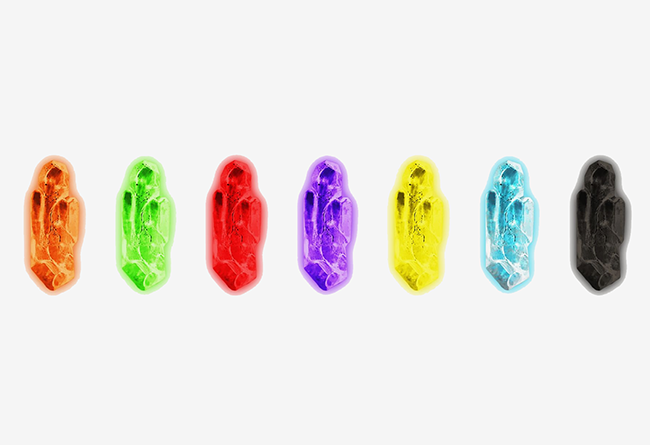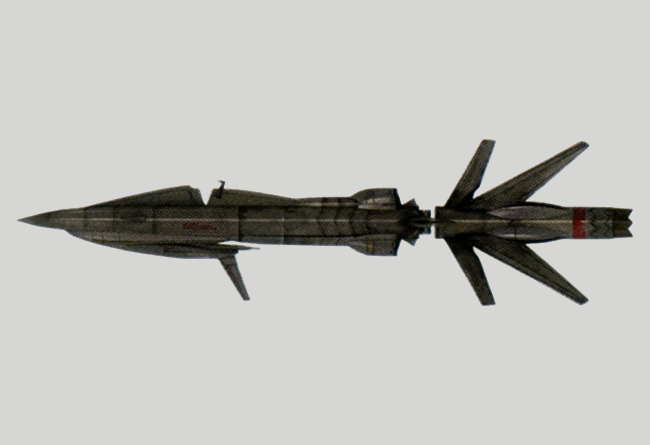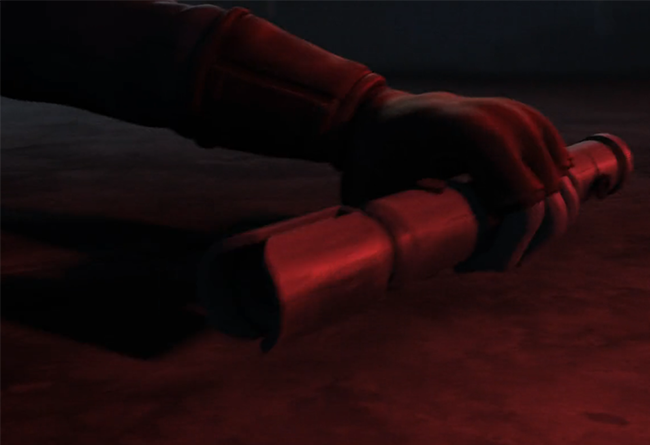Model: Kyber Crystal
Type: Lightsaber Crystal
Skill: Lightsaber Repair
Cost: Not available for sale
Availability: X
Game Notes:
Colorless: Colorless prior to being bonded with a Force-sensitive individual, the process then results in different hues.
Known Locations: Adega, Christophsis, Dantooine, Exegol, Ilum, Jedha, Lothal, M’haeli, Mygeeto, Tatooine, Utapau, Y’ness, and Zoph
Background: Kyber crystals were Force-attuned crystals that grew rarely but throughout the galaxy, with some areas having a greater abundance than others. The crystals concentrated energy in a unique manner through the Force, resonating with it. The crystals exhibited a sort of “collective consciousness,” verging on sentience, and could non-verbally communicate with both one another and living beings. Some theorized that the permutations in the kyber lattice were comparable to emotional shifts in a sentient being.
Internally, kyber crystals were composed of both organic and inorganic matter. They were stable at temperatures and pressures found in the cores of large stars, and were thus impervious to fire and resistant to hammering, and noted for their intricate patterns. Kyber crystals were sturdy enough to survive the violent explosion of a lightsaber’s power grid, such as those caused by accidentally inverting the emitter matrix during the weapon’s assembly. Kyber crystals would not warm a sheath or a towel or any inanimate object, responding only to life, including plant life. If an individual were to wrap their hand around a crystal, the crystal would warm, but not change in temperature. The crystals grew in an organized way, adding to their prismatic structure one piece at a time. They had no discernible lifespan, and thus could be found from sizes as small as a fingernail to gigantic proportions. All kybers were attuned to the Force regardless of their size. Incorrectly pumping laser energy into the crystals weakened their lattices in the same way living cells were affected by radiation.
True kybers were only found in veins of pure kyberite. If the crystal contained impurities, it was regarded as a false kyber. Ranite was closely related to kyberite, but was denser and tougher, and did not contain kyber crystals. Crystals were typically brought to the surface of planets by movements along fault lines, exhumed from the high temperatures and pressure conditions in which they formed. The crystals could be mined from secondary deposits in streams, perhaps following long transport, owing to their mechanical and chemical resilience. Alternately, they could be found in their primary, in situ positions, having grown into free space on the walls of lava tubes, caves, fault zones and within veins of kyberite.
Kyber crystals were most notably found in Ilum’s Crystal Cave. They were a critical component in the construction of lightsabers, focusing energy into the weapon’s distinct plasma blade. The crystals shared a special relationship with the Jedi for tens of thousands of years, and welcomed them to hear their song and learn their lessons. Jedi younglings traveled to the ice caves to harvest their own crystals, which they then used to build their lightsabers. The Force guided their selection, finding a crystal that matched them as Jedi. To those not meant to receive it, the crystal was cold to the touch, but those the crystal chose would hear its “music” and “harmony,” becoming attracted to it. Crystals lacked color before they were chosen by a Jedi. Once chosen, most lightsabers became blue or green, though other shades were created in some instances, most notably Mace Windu’s purple blade, the yellow blades of the Jedi Temple Guards, the black Darksaber, and Ahsoka Tano’s white lightsabers. The resulting crystal and blade color was decided through shifting to match the nature of the bonded owner. It was possible to alter the angle or frequency of a kyber crystal or lightsaber blade, in order to change the color of the latter. This was done by Jedi Knight Anakin Skywalker on former Padawan Ahsoka Tano’s lightsabers.
Kyber crystals were inherently attuned to the light side of the Force, and resisted any effort by dark-side practitioners to use them in lightsabers, with one crystal in particular (the green crystal within Jedi Master Kirak Infil’a’s lightsaber) subjecting Darth Vader to intense visions that almost drove him insane. To this end, a Sith or other dark-sider could use a kyber crystal only by using the Force to dominate the crystal, bending it to their will. This process caused the crystal to “bleed,” as if it were a living organism, resulting in the distinctive red or crimson-bladed lightsabers synonymous with the Sith. It was possible to “heal” a corrupted kyber crystal. One known instance of purifying a corrupted kyber crystal was when Ahsoka Tano purified the two crystals she retrieved from the Sixth Brother’s lightsaber following his defeat. In this case, the crystals turned white.
The crystals were noted for their unmatched ability to channel energy and generate enormous returns. To this end, numerous individuals attempted to make synthetic kyber crystals, though their artificial nature made them highly unstable and explosive. If a crystal was subjected to forceful attempts to study it or harness its power, it would “flee” such attempts, hindering those that sought to use it against its will. Furthermore, those that worked in proximity to them would experience headaches and a loss of sleep, becoming incessantly fanatic and fixated over the crystal in the process.
For centuries, the Jedi cut and faceted the crystals to eliminate occlusions and intensify their power yield. Galen Erso theorized that larger crystals needed to be faceted, not only to eliminate these occlusions, but also to minimize diffraction resulting from the introduction of energy from a lasing medium. With proper faceting, the pulse of energy released by the crystal could be greatly amplified and, with the help of containment devices, provide inexpensive power for developing worlds, or be directed into a collimating beam of incredible power, as was used on the DS-1 battle station. Galen Erso also theorized that increased energy yield could be further attained by forcing what the Jedi called the “day and night” lattices of the Force to realign. By realigning the crystals’ lattices along the dark or nighttime axis of the Force, Galen postulated that it could allow for greater control over the crystal’s tendency to diffract. Thus, technology could be used to force the crystals to obey their masters. The abundant yield could then be siphoned off, contained, and used as enriched energy. Without containment, the yield could result in a catastrophic event, capable of wiping out a large population center.
Specifically, when one giant kyber crystal was destabilized by Saw Gerrera, it absorbed so much energy that when it finally did reach critical mass, it exploded with enough force to destroy both the freighter transporting it and a nearby Star Destroyer.





